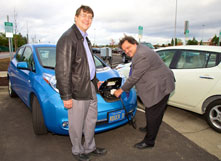Electric car chargers mark a new milestone in CSUEB's sustainability journey
- November 20, 2012 1:00pm
This week Cal State East Bay officially unveiled two new electric car charging stations from their protective plastic sheeting and “plugged in” to the next generation of alternative commuting. The upgraded stations, each with two 208-volt chargers and a 120-volt plug, are adapted for newer models of electric vehicles and hybrids, allowing faculty, staff, students, and visitors to “fuel up” on the Hayward campus at one of the six spaces now reserved for electric vehicles. (See more photos in the gallery.)
Provost James Houpis welcomed about 50 community members to Parking Lot G on the windy Tuesday morning, setting a light tone in a pun-filled introduction. These stations, made possible by the Reconnect California Grant Program, are the latest step in a long-term plan for greener CSUEB campuses — including alternative energy, public transit, and academic exploration of sustainability issues.
Houpis also recognized Evelyn Munoz, CSUEB’s energy manager, who worked with the funding agencies and the university’s facilities department to get the new equipment up and running. Although the University does provide power to the stations, the equipment and installation were free of charge as part of the grant. ClipperCreek, the manufacturer, provided Certified Electrical Car trained electricians for the final connection to the stations.
Since the charging stations have been installed and operational since October, the ceremony was largely symbolic, the provost noted, eyeing two Nissan Leafs and a Chevy Volt already parked near the podium. But the official unveiling was an occasion to recognize what the stations mean to CSUEB and its commitment to sustainability.
Taking the microphone, Michael Lee, professor of geography and environmental sciences, shared some of the history of CAFE (Corporate Average Fuel Economy) fuel standards and regulations in the US, which were recently raised to a goal of 54.5 miles per gallon of gasoline by 2025. That will likely cause the market share of electric and hybrid cars to rise, especially as technology advance. In California, the number of those vehicles on the road is expected to top 112,000 within three years.
In response, Lee said, it’s important for cities and institutions like CSUEB to improve this kind of plug-in infrastructure, to support adoption of alternative vehicles in the community and the region.
